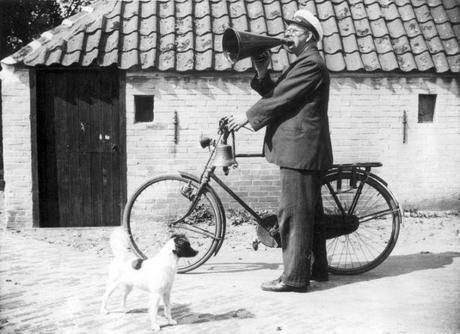This post was written for my 16-year-old cousin Lola, who recently told me that she wants to be a journalist.
So, let’s start by making sure she knows what she’s getting into, shall we?

Town-crier announcing the latest news on the island of Terschelling, the Netherlands, 1938.
Throughout time and across societies, human beings have had a basic need for knowledge beyond their own experiences.
Long before the internet, the newspaper and the 6 o’clock news, certain community members dedicated themselves to gathering and sharing information about the events and issues of the day. (Think: messengers, town criers, minstrels or coffee house nouvellistes.)
And for the past few decades, the term “journalist” has referred to a person — usually a man, often without formal qualifications —who earns a living by writing for a newspaper or periodical. This educational video from the 1940s sums it up well.
In the late 19th and early 20th century, many journalists began to think of their craft as a profession, with writers and editors forming organizations, and university departments offering formal education in journalism.
Journalists also identified with a particular medium. The Oxford English Dictionary still offers a platform-centric definition of journalism, describing it as “the activity or profession of writing for newspapers or magazines or of broadcasting news on radio or television.” (No mention of and/ors and the internet!)
Journalists’ identities have traditionally been tied to their newsrooms — or their respective “fortresses” as the BBC’s Peter Horrocks would say. Their daily task was simple: “to battle journalists from other fortresses.” (Think: scooping the competition on a hot story, scoring a high-profile interview, or being able to say “you heard it here first” after big news breaks.)
So, what has changed?
If we fast-forward to the state of the news media today, we find that journalism as our parents and grandparents knew it has morphed into something very different.
Understanding journalism is now a much more complicated task, as platforms converge and media-making tools become more widely available to the general public.
Long-established patterns of news production and consumption are being challenged by several forces, including:
- Improvements in mobile and networking technology.
- The digitization of content.
- The convergence of platforms.
- The reorganization of social relationships (from top-down to networked)
- Changes in business models and structures of ownership.
- The rise of participatory or citizen journalism.
Mainstream news organizations can no longer count on the control that comes with the scarcity of printing presses, airwaves and broadcast licenses, nor can they bank on the stable flow of advertising dollars, nor are they guaranteed the steadfast attention of increasingly disloyal audiences.
And so, as the media landscape changes, some thinkers have preferred to focus on journalism’s function above its form or platform. Here are a few useful definitions:
- Veteran journalists and authors Bill Kovach and Tom Rosenstiel argue that we need news “to live our lives, to protect ourselves, bond with each other, identify friends and enemies. Journalism is simply the system societies generate to supply this news”.
- Michael Schudson, an award-winning historian of journalism, defines it as “the business and practice of producing and disseminating information about contemporary affairs of general public interest and importance.”
- Similarly, influential communications theorist James Carey noted that “news is a historic reality,” or an invented cultural form that both comprises and reflects a particular “hunger for experience” that has tended to be historically grounded in the “changing style and fortunes of the middle class”.
- Sociology professor Gaye Tuchman says that a news report is a story, which is not to say that it is fictitious, but rather to remind us that news is a “constructed reality with its own internal validity”.
Journalism has been called a craft, a field, a job, a business, an art form … and a few less pleasant things I’m sure. Indeed, it is all of these things for different people, and thus an object of debate in and of itself.
Where are we heading?
As this shift occurs, it is no longer enough to identify journalists by employer or platform alone. Few rookie reporters expect to work for one employer their whole lives, and many are developing a personal brand instead of depending on their newsroom’s reputation.
Many journalists can now write print stories, and make videos, and live-tweet the news as it happens, etc.

My 16-year-old cousin Lola — the future face of journalism?
They sort of had to up the ante, as new players are increasingly getting involved in the stages of news production long controlled by trained professionals – whether they are bloggers challenging the established 24-hour news cycle to put “old news” back on the agenda , or citizens committing “acts of journalism” before the mainstream media can get there.
Horrocks notes that the fortresses are crumbling, and “courtly jousts with fellow journalists are no longer impressing the crowds.”
I wrote my thesis on this, and let me tell you: the recent literature is a sea of ideas to re-think, re-vamp, re-position, re-envision, and re-structure the definition of journalism.
Outside pressures are now forcing conversations that have not been popular for years — but some argue that this period of reflection may also be an opportunity. Schudson notes that journalism’s public nature and vulnerability is precisely what keeps it alive, changing and growing.
Perhaps by necessity, more reporters are taking the time to think about what defines their work, and why it matters.
As internet visionary Clay Shirky writes:
“Because social effects lag behind technological ones by decades, real revolutions don’t involve an orderly transition from point A to point B – Rather, they go from A through a long period of chaos and only then reach B. In that chaotic period, the old systems get broken long before new ones become stable.”
So that, Lola, is a brief overview of this crazy thing called journalism. If you’re still interested, plug in your headphones and let CBC’s Ira Basen explain why your parents are much more surprised by all of this than you are.
Part One
Part Two
And when you’re done with all that, check out this blog I built for young people looking for practical advice: So, you want to be a journalist?
It features the advice from some of Canada’s most promising young reporters who call tell you all about the dilemmas, pains and absolute joys of these new circumstances.
Related posts from the Fab Files:
- Whatever else changes, we still need a principled press.
- Should entrepreneurial journalists flock to grad schools?
- How sensitive can a journalist be?
- Journalism? Are you crazy?
- Big reporters do cry
- Doing journalism the June Callwood way
- Smarter Beach Books: a journalist’s shortlist
